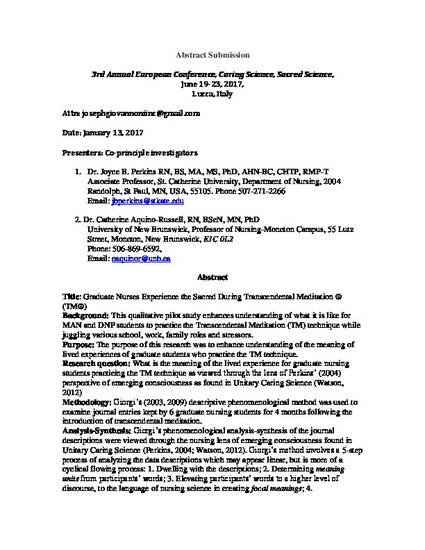
Presentation
Graduate Nurses Experience the Sacred During Transcendental Meditation ® (TM®)
3rd Annual European Conference, Caring Science, Sacred Science, June 19-23, 2017, Lucca, Italy: Watson Caring Science Institute (WCSI)
(2017)
Abstract
Title: Graduate Nurses Experience the Sacred During Transcendental Meditation ® (TM®)
Background: This qualitative pilot study enhances understanding of what it is like for MAN and DNP students to practice the Transcendental Meditation (TM) technique while juggling various school, work, family roles and stressors.
Purpose: The purpose of this research was to enhance understanding of the meaning of lived experiences of graduate students who practice the TM technique.
Research question: What is the meaning of the lived experience for graduate nursing students practicing the TM technique as viewed through the lens of Perkins’ (2004) perspective of emerging consciousness as found in Unitary Caring Science (Watson, 2012)
Methodology: Giorgi’s(2003, 2009) descriptive phenomenological method was used toexamine journal entries kept by 6 graduate nursing students for 4 months following the introduction of transcendental meditation.
Analysis-Synthesis: Giorgi’s phenomenological analysis-synthesis of the journal descriptions were viewed through the nursing lens of emerging consciousness found in Unitary Caring Science (Perkins, 2004; Watson, 2012). Giorgi’s method involves a 5-step process of analyzing the data descriptions which may appear linear, but is more of a cyclical flowing process: 1. Dwelling with the descriptions; 2. Determining meaning units from participants’ words; 3. Elevating participants’ words to a higher level of discourse, to the language of nursing science in creating focal meanings; 4. Amalgamating focal meanings to become situated structural descriptions (SSDs) for each participant; and 5. Removing specific information from each SSD and joining the essences together to synthesize the meaning of the lived experience (general structural description) for all participants.
Findings: When practicing this simple technique of Transcendental Meditation™, students found themselves authentically present and balanced,with feelings of bliss, peacefulness, and inner integrity foremost, which potentiated the experience of sacred space amidst daily stressors whilstcare, compassion, grace, gratitude, and appreciation resided within.
References:
Giorgi, A. (2009). The descriptive phenomenological method in psychology: A modified Husserlian approach. Pittsburgh, PA: Duquesne University Press.
Giorgi, A. P., & Giorgi, B. M. (2003). The descriptive phenomenological psychological method. In P. M. Camic, J. E. Rhodes, & L. Yardley (Eds.), Qualitative research in psychology: Expanding perspectives in methodology and design. Washington, DC: American Psychological Association.
Perkins, J. (2004). A cosmology of compassion for nursing explicated via dialogue with self, science, and spirit, UMI Dissertation Services, University of Colorado Health Science Center Denver, CO.
Watson, J. (2012). 2nd Ed. Human caring science: A theory of nursing, Sudbury, Mass.: Jones & Bartlett Learning. ISBN 978-1-4496-2810-9
Disciplines
- Nursing and
- Other Nursing
Publication Date
Summer June 19, 2017
Citation Information
Joyce B Perkins. "Graduate Nurses Experience the Sacred During Transcendental Meditation ® (TM®)" 3rd Annual European Conference, Caring Science, Sacred Science, June 19-23, 2017, Lucca, Italy: Watson Caring Science Institute (WCSI) (2017) Available at: http://works.bepress.com/joyce-perkins/16/
